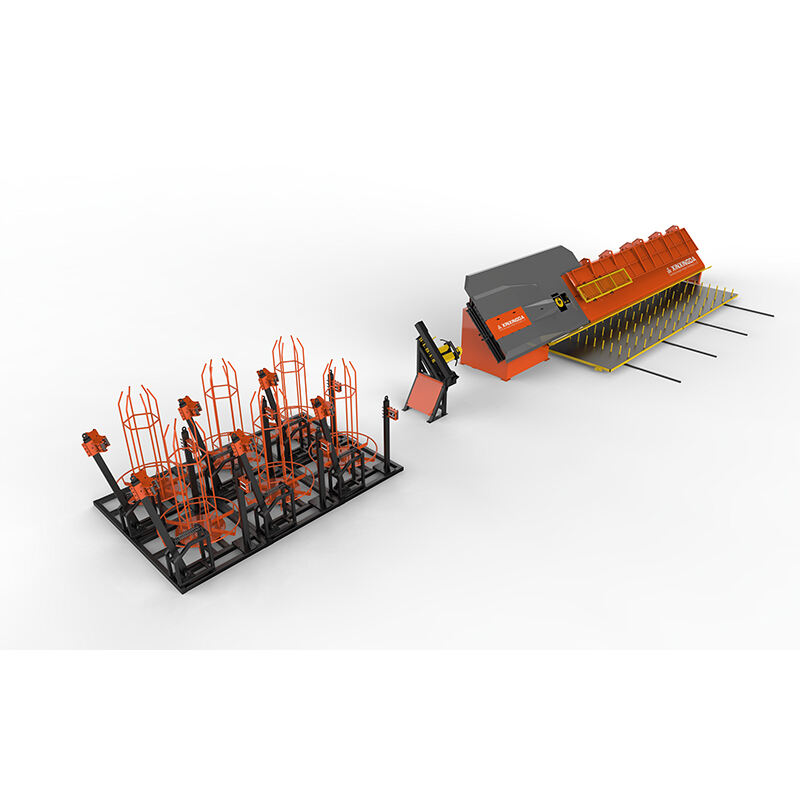In the construction and manufacturing industries, precision and reliability are paramount when it comes to metalworking equipment. A circle and arc bending machine represents one of the most critical tools for creating curved structural elements, decorative components, and specialized architectural features. These sophisticated machines must deliver consistent performance under demanding conditions while maintaining exceptional accuracy in their bending operations. Understanding the key features that contribute to a machine's reliability can help businesses make informed decisions when investing in this essential equipment.
The reliability of bending machinery directly impacts production efficiency, product quality, and overall operational costs. When evaluating different models and manufacturers, operators must consider various technical specifications, build quality factors, and performance characteristics that distinguish superior equipment from standard alternatives. Modern circle and arc bending machines incorporate advanced technologies and engineering solutions that enhance their durability, precision, and operational longevity.
Structural Foundation and Frame Design
Heavy-Duty Frame Construction
The foundation of any reliable circle and arc bending machine begins with its structural framework. Premium machines feature heavy-duty steel frames constructed from high-grade materials that can withstand the substantial forces generated during bending operations. These frames typically incorporate reinforcement ribs, strategic cross-bracing, and precision-machined surfaces that maintain dimensional stability over years of continuous use. The frame design must distribute bending forces evenly while minimizing deflection and vibration that could compromise accuracy.
Manufacturing processes for these frames often involve stress-relief treatments and precision machining to eliminate internal tensions that could lead to warping or dimensional changes over time. The best machines utilize cast iron or welded steel construction with sufficient mass to absorb operational forces without transmitting vibrations to the workpiece. This solid foundation ensures that bending operations remain consistent and predictable regardless of material thickness or bending radius requirements.
Precision Alignment Systems
Reliable bending machines incorporate sophisticated alignment systems that maintain precise relationships between all moving components throughout the machine's operational life. These systems include precision-ground guide rails, linear bearings, and adjustment mechanisms that can compensate for normal wear patterns. The alignment system must ensure that bending rollers, pressure systems, and workpiece guides maintain their specified positions within tight tolerances.
Advanced machines feature self-monitoring alignment systems that can detect deviations and alert operators to maintenance requirements before accuracy is compromised. This proactive approach to alignment maintenance helps prevent costly production errors and extends the machine's useful life. The integration of digital measurement systems allows for real-time monitoring of critical alignments during operation.
Hydraulic and Drive Systems
High-Performance Hydraulic Components
The hydraulic system represents the heart of most modern bending machines, providing the precise force control necessary for consistent results. Reliable machines utilize high-quality hydraulic pumps, valves, and cylinders designed for continuous duty cycles and precise pressure regulation. These components must deliver smooth, controllable force application while maintaining consistent pressure levels throughout extended bending operations.
Premium hydraulic systems incorporate proportional control valves that allow for infinite adjustment of bending speed and force application. This level of control enables operators to optimize bending parameters for different materials and geometries while preventing damage to delicate workpieces. The hydraulic system should also include comprehensive filtration, temperature control, and pressure monitoring systems that protect components from contamination and overheating.
Advanced Motor and Drive Technology
Modern circle and arc bending machine systems rely on sophisticated motor and drive technologies to achieve precise positioning and smooth operation. Servo motors and variable frequency drives provide exceptional speed control, positioning accuracy, and energy efficiency compared to traditional fixed-speed systems. These advanced drives can automatically adjust operating parameters based on material properties and bending requirements.
The integration of feedback systems allows drive components to continuously monitor and adjust their performance, compensating for variations in material properties, tool wear, and environmental conditions. This adaptive capability ensures consistent results across different production runs while minimizing operator intervention requirements. Energy-efficient drive systems also reduce operational costs and heat generation within the machine.

Control Systems and Automation Features
Programmable Logic Controllers
Contemporary bending machines incorporate advanced programmable logic controllers that manage all aspects of machine operation through sophisticated software systems. These controllers process input from multiple sensors, coordinate complex motion sequences, and provide comprehensive diagnostic capabilities that help operators identify and resolve issues quickly. The control system must be intuitive enough for operators to program complex bending sequences while providing sufficient flexibility to accommodate diverse production requirements.
Reliable control systems feature redundant safety circuits, backup power systems, and robust data storage capabilities that protect program information and maintain operational continuity. The software interface should provide clear visual feedback about machine status, operational parameters, and maintenance requirements. Advanced systems can store thousands of bending programs and automatically select appropriate parameters based on material specifications and desired outcomes.
Sensor Integration and Feedback Systems
Modern machines incorporate extensive sensor networks that monitor critical operational parameters in real-time. Position sensors, force transducers, and temperature monitors provide continuous feedback about machine performance and workpiece conditions. This sensor data enables the control system to make automatic adjustments that maintain consistent bending quality while protecting equipment from damage.
The integration of vision systems and measurement devices allows machines to verify bend angles and dimensions during the forming process, enabling immediate corrections if deviations are detected. This closed-loop control approach significantly improves production quality while reducing waste and rework requirements. Advanced sensor systems can also predict maintenance needs by monitoring component wear patterns and operating conditions.
Tooling and Work-Holding Systems
Precision Tooling Design
The reliability of a circle and arc bending machine depends heavily on the quality and design of its tooling systems. Precision-manufactured bending dies, rollers, and forming tools must maintain their dimensional accuracy throughout millions of bending cycles while resisting wear and deformation. Premium tooling utilizes specialized materials and surface treatments that provide exceptional durability and consistent performance.
Modular tooling systems allow operators to quickly change configurations for different bending requirements while maintaining precise alignment and positioning. The tooling must accommodate various material sizes and properties while providing consistent support and guidance throughout the bending process. Quick-change mechanisms reduce setup times and improve productivity while ensuring repeatable tool positioning.
Advanced Clamping and Positioning
Reliable work-holding systems provide secure clamping force while allowing smooth material movement during bending operations. These systems must accommodate varying material dimensions and properties while maintaining consistent positioning accuracy. Advanced clamping mechanisms utilize servo-controlled actuators that can adjust clamping force based on material properties and bending requirements.
The positioning system should provide precise control over material placement and orientation while allowing for easy loading and unloading operations. Automated positioning features can reduce operator fatigue and improve consistency while minimizing the potential for positioning errors that could result in scrapped parts or machine damage.
Safety and Protection Features
Comprehensive Safety Systems
Reliable bending machines incorporate multiple layers of safety protection to protect operators and equipment from potential hazards. Emergency stop systems, light curtains, and pressure-sensitive mats provide immediate shutdown capabilities when unsafe conditions are detected. These safety systems must be integrated with the machine's control system to ensure coordinated responses to emergency situations.
Overload protection systems monitor bending forces and automatically halt operations if predetermined limits are exceeded, preventing damage to workpieces, tooling, and machine components. These protection systems should be adjustable to accommodate different materials and bending requirements while maintaining appropriate safety margins. Visual and audible warning systems alert operators to potentially dangerous conditions before they become critical.
Equipment Protection Mechanisms
Advanced protection systems monitor machine components for signs of wear, overheating, or malfunction that could lead to equipment failure or reduced reliability. Temperature sensors, vibration monitors, and pressure switches provide early warning of developing problems that require maintenance attention. These systems help prevent catastrophic failures that could result in extensive downtime and repair costs.
Automatic lubrication systems ensure that critical components receive appropriate maintenance without relying on manual intervention. These systems can be programmed to deliver precise amounts of lubricant at optimal intervals, extending component life while maintaining consistent performance. Contamination detection systems protect hydraulic and pneumatic components from damage caused by dirty fluids or compressed air.
Maintenance and Serviceability Features
Accessible Design for Maintenance
Reliable machines are designed with maintenance accessibility as a primary consideration, featuring removable panels, strategically positioned service points, and clear component labeling that facilitates routine maintenance tasks. The machine layout should provide adequate space for technicians to access all components safely while minimizing the need for special tools or equipment during routine service procedures.
Diagnostic systems provide detailed information about machine status and maintenance requirements, helping technicians identify issues quickly and accurately. Self-diagnostic capabilities can automatically detect common problems and guide operators through troubleshooting procedures, reducing downtime and service costs. Comprehensive maintenance documentation and video guides enhance technician capabilities and reduce training requirements.
Component Quality and Longevity
The selection of high-quality components from reputable manufacturers significantly impacts machine reliability and service life. Premium bearings, seals, electrical components, and wear parts should be sourced from established suppliers with proven track records in industrial applications. Component standardization allows for easier maintenance and reduces inventory requirements while ensuring parts availability.
Predictive maintenance capabilities utilize sensor data and historical performance information to forecast component replacement requirements before failures occur. This proactive approach minimizes unplanned downtime while optimizing maintenance costs and resource allocation. The machine should provide easy access to wear parts and consumables that require regular replacement during normal operations.
FAQ
What is the expected lifespan of a high-quality circle and arc bending machine
A well-maintained, high-quality circle and arc bending machine typically operates reliably for 15-25 years with proper maintenance and care. The actual lifespan depends on factors such as usage intensity, material types processed, maintenance quality, and operating environment conditions. Machines used in moderate production environments with regular preventive maintenance often exceed their expected service life significantly.
How often should hydraulic systems be serviced in bending machines
Hydraulic systems in bending machines should undergo comprehensive service every 1,000-2,000 operating hours or annually, whichever comes first. This includes hydraulic fluid analysis, filter replacement, pressure testing, and seal inspection. Daily checks of fluid levels, temperature, and pressure indicators help identify developing issues before they become serious problems requiring major repairs.
What factors most significantly impact bending accuracy and repeatability
Bending accuracy and repeatability are primarily influenced by machine frame rigidity, tooling precision, control system sophistication, and proper calibration. Environmental factors such as temperature fluctuations, vibration, and material property variations also affect results. Regular calibration procedures, proper tooling maintenance, and consistent operating procedures help maintain optimal accuracy levels throughout the machine's service life.
Can older bending machines be upgraded with modern control systems
Many older bending machines with solid mechanical foundations can be successfully upgraded with modern control systems, servo drives, and safety equipment. These retrofits can significantly improve accuracy, productivity, and safety while extending machine life. The feasibility depends on the machine's structural condition, existing electrical systems, and the availability of compatible upgrade components from the original manufacturer or specialized retrofit companies.


